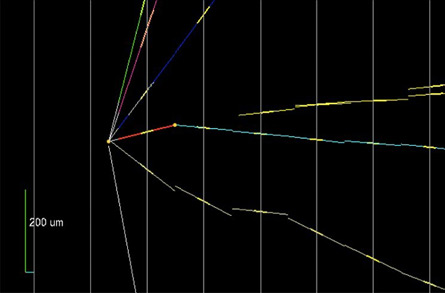In a truly transformative event, physicists have for the first time found direct evidence that a neutrino, a ghostly elementary particle that barely interacts with matter, morphs from one type into another. The finding, announced May 31 in a news release, provides additional support for the notion that neutrinos have mass, a property that requires an explanation beyond the realm of the standard model of particle physics.

Since the late 1990s, experiments such as Super-Kamiokande in Japan have indicated that neutrinos spontaneously transform themselves, or oscillate, among three varieties or “flavors”: the electron neutrino, the muon neutrino and the tau neutrino. Such oscillations indicate that neutrinos, long thought to be weightless, must have some small amount of mass.
Those experiments revealed a lower-than-predicted abundance of a certain type of neutrino compared with the number produced at the neutrinos’ source. The abundance of that type had clearly declined, but it wasn’t clear which type of neutrino they had transformed into.
The new experiment not only shows a strong hint of just such a transformation but also identifies tau neutrinos as the type produced. The finding is based on three years of neutrino data recorded by the Oscillation Project with Emulsion-Tracking Apparatus, or OPERA, at the underground Gran Sasso National Laboratory near Rome.
Theorist Rabindra Mohapatra of the University of Maryland in College Park, not a member of the discovery team, calls the result a “magnificent confirmation” that neutrinos oscillate among three types. “The OPERA detector was built with that purpose, and clearly they have succeeded,” he says.
OPERA uses as its source an intense beam of pure muon neutrinos generated at CERN in Geneva. The analysis indicates that a muon neutrino changed into a tau neutrino sometime during the roughly 730-kilometer, 2.4-millisecond journey of the high-speed particles from Switzerland to Italy.
In 2001, the Sudbury Neutrino Observatory in Ontario found both a deficit of identifiable electron neutrinos emitted by the sun and a commensurate increase in a mixture of tau, muon and electron neutrinos (SN: 6/23/01, p. 388), says astrophysicist Michael Turner of the University of Chicago. That experiment, unlike OPERA, could not identify which types of neutrinos the electron neutrinos had transformed into.
“The importance of this observation is that for the first time a [specific] new flavor of neutrino has been seen to appear,” says theorist John Ellis of CERN, also not part of the experimental team. “We now know where those missing neutrinos [in past experiments] have been going. It’s a bit like a shopkeeper discovering that cash keeps disappearing from the till. She couldn’t charge the cashier with theft until she finds some money in his pocket.”
While not a breakthrough, Turner says, the new finding is “a very important step on the path to understanding how neutrinos have shaped our universe.” Neutrinos play a key role in triggering supernova explosions, which seed the universe with the bulk of its heavier elements, and may also contribute to dark matter, the invisible material that accounts for 85 percent of the mass of the cosmos.
Because the OPERA finding is but a single detection among billions of neutrino events, it will require confirmation with about five or six additional events, cautions OPERA spokesman Antonio Ereditato of the University of Bern in Switzerland. The presumed transformation has a 98 percent chance of being correct, the team said.
Detecting a transformation is notoriously difficult because neutrinos are nearly massless and have no charge. More than 50 trillion pass unimpeded through a human body each second.
OPERA searches for the interaction and decay of tau neutrinos within 150,000 “bricks” — layered units of lead plates and photographic film. The experiment’s underground location shields it from cosmic rays, energetic charged particles from space that can interfere with the operation of electronic detectors associated with the bricks.
The first neutrino oscillation experiments, dating back some 15 years, were conducted to understand a long-standing puzzle about why nuclear burning at the sun’s core seemed to be producing substantially fewer electron neutrinos than predicted. The experiments revealed that about one-third of the electron neutrinos had disappeared on their way to Earth, presumably because they had transformed into another type of neutrino.
Before the OPERA result, some researchers had suggested that a fraction of the missing neutrinos might have disappeared into a proposed fourth type, known as a sterile neutrino, which would not have shown up in any detector, notes particle theorist Joseph Lykken of the Fermi National Accelerator Laboratory in Batavia, Ill., who is not a participant in the experiment. Sterile neutrinos have been suggested as a way of understanding the results of neutrino oscillation experiments such as Fermilab’s Mini-Boone, or booster neutrino experiment, which don’t seem to fit the standard neutrino model.
“With only one neutrino appearance event, OPERA does not yet tell us anything new about sterile neutrinos, but it is an important step towards getting a direct handle on this exciting possibility,” says Lykken.
Several other questions remain in trying to understand neutrinos, says theorist Joshua Frieman, also of Fermilab. Researchers would like to determine if the lightest neutrino consists mainly of an electron neutrino and if the heavier ones are mixtures of the muon and tau neutrinos. In addition, physicists want to know if neutrinos and antineutrinos behave differently when they decay, a phenomenon known as CP violation.
“These questions are motivating the design of new long-baseline neutrino oscillation experiments,” Frieman says. One such experiment would shoot a neutrino beam from Fermilab to a huge detector in a proposed underground lab in South Dakota, he says.







